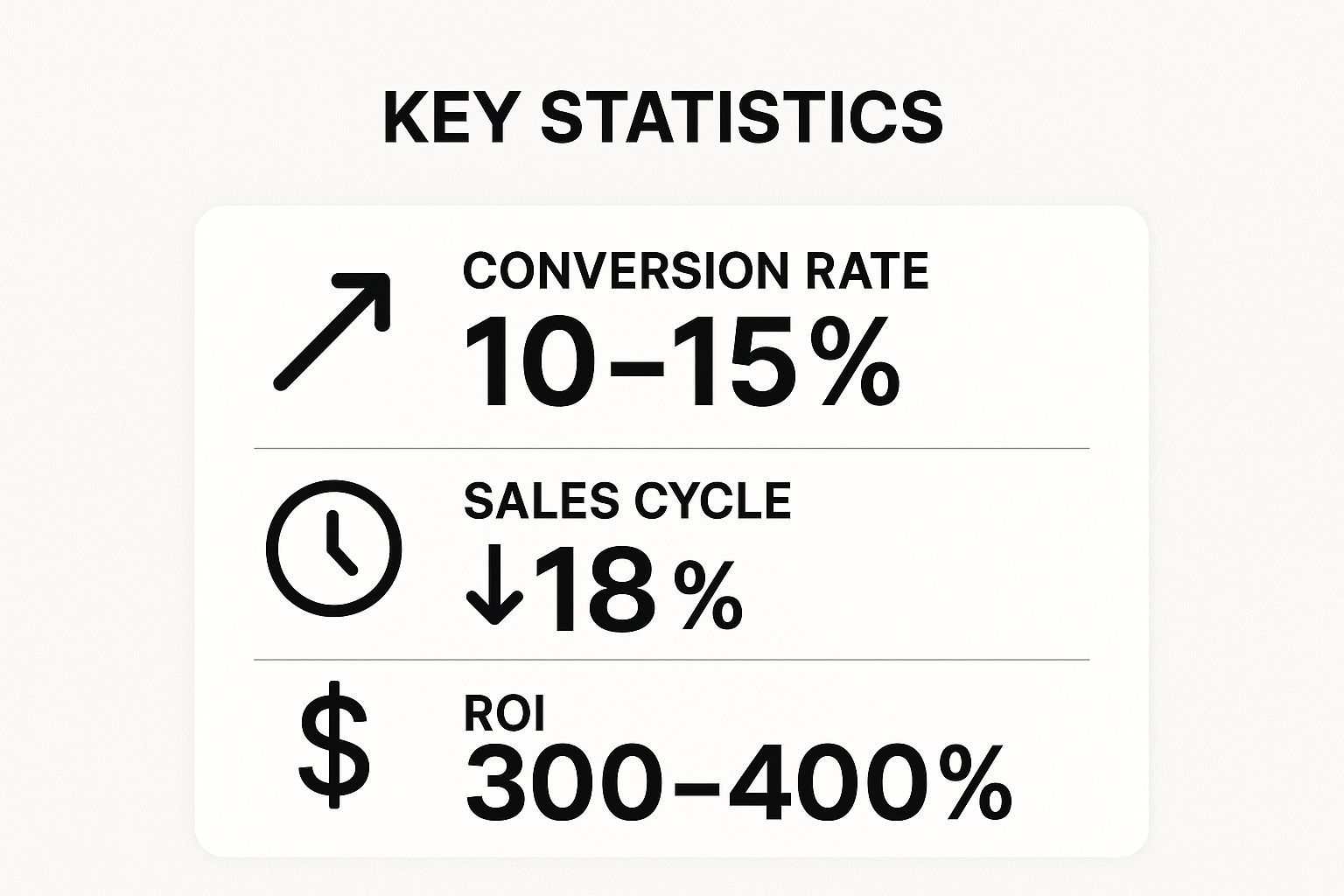In today's competitive market, 'doing more with less' is a fundamental strategy for growth. For B2B and professional services firms, the pressure to generate qualified leads, navigate complex sales cycles, and demonstrate tangible ROI has never been greater. This is where marketing automation evolves from a buzzword into a critical engine for sustainable growth. Its purpose is not to replace marketers, but to empower them to build smarter, more scalable, and deeply personal client relationships.
This article cuts through the noise to explore the seven most impactful marketing automation benefits that translate directly into improved efficiency, enhanced customer experiences, and measurable revenue growth. We will move beyond theory to explore practical applications and actionable steps tailored for B2B contexts.
You will learn how to:
- Implement advanced lead nurturing and scoring.
- Achieve true personalization at scale.
- Optimize multi-channel campaign management.
- Improve performance analytics and prove ROI.
By understanding these core advantages, you can strategically align your marketing efforts with core business objectives, ensuring every action contributes directly to the bottom line. Let's explore how to harness this technology for tangible results.
1. Supercharge Your Funnel with Automated Lead Nurturing and Scoring
One of the most transformative marketing automation benefits is the ability to systematically guide prospects from initial interest to sales-readiness. Instead of a generic, one-size-fits-all approach, you can create tailored communication sequences that respond to user behavior in real time, delivering the right message at precisely the right moment.
Simultaneously, lead scoring algorithms work behind the scenes, assigning points for high-intent actions like visiting a pricing page or downloading a case study. This dual-engine approach ensures your sales team focuses its valuable time on the most engaged leads, dramatically boosting conversion rates and shortening the sales cycle. It transforms lead management from a manual guessing game into a precise, data-driven process.
The Power of Nurturing and Scoring
Platforms like HubSpot, Marketo, and Pardot have pioneered this method, proving its effectiveness. For instance, companies using advanced lead nurturing generate 50% more sales-ready leads at a 33% lower cost. This isn't just about sending automated emails; it's about building a relationship by providing value until a prospect is ready for a sales conversation.
The infographic below highlights the direct business impact of implementing these automated systems.

These statistics underscore a clear message: automating your nurturing and scoring processes directly translates to higher conversion rates, a more efficient sales cycle, and a powerful return on investment.
How to Implement It Effectively
Getting started doesn't have to be complex. The key is to build a solid foundation and refine it over time.
- Align Sales and Marketing: Before building anything, ensure your sales and marketing teams agree on the definition of a "sales-qualified lead" (SQL). This shared understanding is the bedrock of your scoring model.
- +10 points for a demo request.
- +5 points for visiting the pricing page.
- +3 points for a whitepaper download.
- -5 points for visiting the careers page (negative scoring).
This strategic approach ensures you are not just collecting leads but actively cultivating them. To explore these concepts in more detail, you can learn more about how B2B marketing automation fuels growth.
2. Personalization at Scale
Another of the most powerful marketing automation benefits is the ability to deliver highly relevant experiences to individuals, no matter the size of your audience. By harnessing customer data, behavioral triggers, and dynamic content, you can make every interaction feel one-to-one, even when communicating with thousands of contacts.
This approach uses automation to insert personalized elements like names, company details, or past interests into emails, landing pages, and other communications. It transforms your marketing from a broad announcement into a targeted conversation, building stronger customer relationships and significantly improving engagement. It’s the difference between a generic flyer and a message that speaks directly to a prospect’s specific needs.
The Power of Personalization
This method has been famously popularized by B2C giants, but its impact in B2B is just as profound. Research shows that 80% of customers are more likely to purchase from a brand that provides personalized experiences. Furthermore, personalized calls-to-action convert 202% better than default versions. These platforms prove that tailoring experiences based on user data is a core driver of revenue and retention.
The image below illustrates how data points are used to create these individualized customer journeys.
When executed correctly, scalable personalization makes customers feel understood and valued, which directly translates into increased loyalty and higher lifetime value.
How to Implement It Effectively
You can begin implementing personalization without a massive data science team. The key is to start small and build complexity as you gather more insights.
- Start with Basic Personalization: Begin with simple yet effective tactics. Use merge tags to include a contact's first name in email subject lines and greetings. You can also segment your audience by industry or job title to send more relevant content.
- Show a case study for the financial services industry to contacts in that sector.
- Display a different headline or call-to-action based on a visitor's location or known interest.
This strategic approach ensures your messaging resonates on a personal level, making your marketing efforts far more effective. To see how these strategies can be applied, you can explore examples of successful B2B marketing campaigns.
3. Time and Resource Efficiency
Perhaps the most universally appreciated of all marketing automation benefits is the profound impact on time and resource efficiency. By automating repetitive, manual tasks, marketing teams are liberated to focus on high-value strategic initiatives like creative development and performance analysis. This shift empowers your best minds to drive innovation instead of getting bogged down in administrative work.

Automating processes like social media scheduling, data entry, report generation, and multi-step email campaigns not only saves countless hours but also minimizes the risk of human error. The result is a marketing engine that runs more smoothly and consistently, allowing companies to scale their efforts without a proportional increase in headcount or budget.
The Power of Efficiency
The impact is clear: businesses that use marketing automation experience an average 14.5% increase in sales productivity and a 12.2% reduction in marketing overhead. This isn't just a strategy for large enterprises; it's a competitive advantage for any organization looking to maximize its impact.
Automating workflows ensures consistent brand messaging and timely follow-up, freeing your team to engage in the critical thinking and relationship-building that machines cannot replicate.
How to Implement It Effectively
The key to maximizing efficiency is to be strategic and deliberate in your automation efforts.
- Map Your Repetitive Processes: Before investing in any tool, conduct an audit of your team's daily and weekly tasks. Identify the most time-consuming, rule-based activities that are prime candidates for automation.
- Implement Gradually: Start with one or two high-impact, low-risk processes, such as a welcome email series for new subscribers. This allows your team to learn the platform and test workflows without disrupting major operations.
- Maintain Human Oversight: Automation is a tool, not a replacement for strategy. Regularly review the performance of automated campaigns and workflows to identify opportunities for optimization and ensure quality control.
- Train Your Team for Optimization: Equip your team with the skills not just to use the automation software, but to analyze its performance and continuously refine the systems for better results.
By methodically offloading manual tasks, you create a more productive and strategically focused marketing department. To dive deeper into this, you can explore the fundamentals of marketing workflow automation.
4. Enhanced Customer Journey Mapping and Management
A significant benefit of marketing automation is gaining comprehensive visibility into the entire customer journey, from the first touchpoint to post-purchase advocacy. Instead of guessing how clients interact with your brand, you can track their path across channels, identify friction points, and orchestrate a seamless, cohesive experience that guides them more effectively toward a purchase.
This technology allows you to move beyond fragmented campaign data to see a holistic view of user behavior. By understanding which touchpoints are most effective and where prospects drop off, you can proactively optimize the journey. This data-driven approach transforms marketing from a series of disconnected activities into a strategic, end-to-end system designed for conversion and retention.
The Power of Journey Orchestration
Platforms like Adobe Experience Cloud and Salesforce Marketing Cloud empower businesses to map and automate these complex journeys. Companies that excel at customer journey management see a 15-20% increase in revenue. This is because they can anticipate customer needs and deliver relevant content at critical moments in the buying cycle.
The real power lies in using automation to trigger personalized interactions at key moments, ensuring no potential client falls through the cracks, regardless of the sales cycle's length or complexity.
How to Implement It Effectively
Mapping and managing the customer journey is an iterative process that starts with a clear plan and evolves with data.
- Map the Current Journey Manually: Before introducing technology, gather your team and whiteboard the existing customer journey. Identify all known touchpoints, from social media ads to sales calls.
- Automate Critical Conversion Points: Don't try to automate everything at once. Focus on high-impact areas first, such as abandoned cart sequences for e-commerce, demo follow-ups for SaaS, or welcome sequences for new subscribers.
- Use Attribution Modeling: Implement multi-touch attribution within your platform to understand which channels and content pieces truly influence conversion. This data is crucial for optimizing your marketing spend.
- Review and Refine Regularly: A customer journey map is not a static document. Use the performance data from your automation platform to continually update and refine your maps based on real user behavior.
This strategic mapping is fundamental to improving client engagement. To dive deeper into this topic, you can learn more about how to get started with customer experience measurement.
5. Improved ROI and Performance Analytics
One of the most critical marketing automation benefits is the ability to connect marketing activities directly to revenue. Instead of relying on vanity metrics, automation platforms provide sophisticated analytics and attribution modeling, giving marketers clear visibility into performance, return on investment (ROI), and the impact of every touchpoint along the customer journey.
This data-driven clarity is transformative. It allows you to prove marketing's value with concrete numbers, justify budget requests, and continuously optimize strategies based on what truly drives results. It shifts the marketing function from a cost center to a predictable revenue engine by answering the fundamental question: "What is working, and how can we do more of it?"
The Power of Data-Driven Decisions
Modern automation suites make it possible to tie a specific blog post, email campaign, or social ad directly to a closed deal. In fact, nearly 80% of top-performing companies have been using marketing automation for more than two years, a testament to the long-term value of its analytical capabilities.
This level of insight empowers teams to double down on high-performing channels and eliminate wasteful spending with confidence, maximizing the impact of every dollar.
How to Implement It Effectively
Achieving true ROI clarity requires a strategic approach to data and reporting. The key is to establish a solid framework before you begin measuring.
- Establish Clear KPIs: Before launching any automated campaign, define what success looks like. Establish key performance indicators (KPIs) like Cost Per Acquisition (CPA), Customer Lifetime Value (CLV), and MQL-to-SQL conversion rates.
- Use Multiple Attribution Models: Don’t rely on a single model (e.g., last-touch). Use first-touch, multi-touch, and linear models to get a complete picture of how different channels contribute to a conversion.
- Integrate Sales and Marketing Data: The most accurate ROI calculation comes from a unified view. Integrate your marketing automation platform with your CRM to track leads from initial contact all the way through to a closed-won deal.
- Create Automated Dashboards: Build automated, real-time dashboards that provide key stakeholders with at-a-glance visibility into campaign performance. This keeps everyone aligned and focused on the metrics that matter.
This focus on measurement ensures your marketing efforts contribute directly to business growth. To get started, you can explore the most important digital marketing performance metrics to track.
6. Scalable Multi-Channel Campaign Management
One of the most powerful marketing automation benefits is the ability to orchestrate complex campaigns across multiple channels from a single platform. Instead of managing email, social media, web, and mobile touchpoints in silos, automation allows you to create a unified, consistent customer journey. This ensures your message remains coherent while being optimized for each specific channel.
This centralized control makes scaling your marketing incredibly efficient. You can launch sophisticated, coordinated campaigns across numerous platforms without needing a proportional increase in your team's size or budget. It transforms campaign management from a fragmented, labor-intensive task into a streamlined, scalable operation that delivers a seamless brand experience.
The Power of a Unified Approach
Omnichannel campaigns powered by automation see 287% higher purchase rates than single-channel campaigns. This is because a unified approach surrounds a prospect with value. For example, a B2B firm can deliver a whitepaper via email, retarget them with a relevant case study ad on LinkedIn, and send an SMS notification about an upcoming webinar.
This multi-pronged strategy keeps your brand top-of-mind and moves leads through the funnel more effectively by engaging them on their preferred platforms.
How to Implement It Effectively
Getting started with multi-channel campaigns requires a strategic, phased approach to avoid becoming overwhelmed.
- Start with Core Channels: Begin by integrating just two or three of your most effective channels, such as email and social media. Master the coordination between them before adding more complexity.
- Maintain Message Consistency: Your core message and value proposition should be consistent everywhere. However, tailor the delivery and call-to-action for each platform’s unique audience and format.
- Time Cross-Channel Touchpoints: Use automation to strategically time your interactions. For instance, trigger a social media ad campaign for users who opened a specific marketing email but did not click the link.
- Monitor Holistically and Individually: Track the performance of each channel on its own, but also analyze the collective impact of the integrated campaign on your overall marketing goals.
This methodical implementation allows you to build a sophisticated, scalable marketing machine. For more insights on building integrated strategies, consider exploring how to align marketing and sales for better results.
7. Advanced Customer Segmentation and Targeting
One of the most powerful marketing automation benefits is the ability to move beyond generic, mass-market messaging. Instead of treating your audience as a monolith, automation platforms allow you to slice your customer base into hyper-specific segments based on their unique characteristics and behaviors, ensuring every message resonates deeply.
This sophisticated segmentation uses a combination of behavioral, demographic, psychographic, and transactional data. By understanding who your customers are, what they care about, and how they interact with your brand, you can craft highly targeted campaigns. This results in significantly higher engagement and improved conversion rates because you're delivering value that speaks directly to individual needs.
The Power of Segmentation and Targeting
The impact of segmentation is undeniable. Marketers who use segmented campaigns note as much as a 760% increase in revenue. This is because targeted messages are inherently more relevant and valuable to the recipient.
This level of precision isn't just for B2C; B2B firms can segment by industry, company size, or a contact's role to deliver relevant case studies and content. The goal is to make each prospect feel like you understand their specific challenges.
How to Implement It Effectively
Effective segmentation is a process of starting simple and adding complexity over time. Use your automation platform to build a dynamic, intelligent system.
- Start with Broad Categories: Begin by creating foundational segments based on easily accessible data. This could include industry, job title, company size, or geographic location.
- Layer in Behavioral Data: Once your basic segments are established, add behavioral criteria. For example, create a segment for contacts who have visited your pricing page more than twice in 30 days or those who have downloaded a specific whitepaper.
- Utilize RFM Analysis: For businesses with transactional data, implement Recency, Frequency, and Monetary (RFM) analysis. This helps identify your most valuable customers so you can create exclusive loyalty campaigns.
- Audit and Refine Regularly: Customer data is not static. Schedule regular audits of your segment criteria to ensure they remain accurate and effective, removing contacts who no longer fit and re-evaluating your definitions.
By adopting this methodical approach, you can turn your marketing automation platform into a precision-targeting tool. To dive deeper into building these audience groups, you can learn more about effective customer segmentation strategies.
Marketing Automation Benefits Comparison
From Automation to Acceleration: Your Next Steps
The journey through the core marketing automation benefits reveals a transformative truth for B2B and professional services firms: this technology is not merely about doing less work. It's about doing smarter, more impactful work that generates predictable revenue and builds stronger client relationships. We've explored how it refines lead nurturing, enables personalization at scale, and frees your team from repetitive tasks to focus on high-value strategic initiatives.
This isn't just about efficiency; it's about intelligence. By mapping and managing the entire customer journey, you gain an unprecedented understanding of client behavior. This clarity, combined with robust analytics, allows you to prove marketing's ROI with hard data. The ability to manage sophisticated multi-channel campaigns and deploy advanced customer segmentation elevates your firm from broadcasting a message to orchestrating meaningful conversations with your ideal prospects.
Turning Insight into Action
The ultimate value of marketing automation lies not in the platform itself, but in the strategic application of its capabilities. The transition from manual processes to an automated ecosystem is a significant step, but it’s the one that unlocks scalable growth. To truly capitalize on these advantages, your focus should shift to a few key areas:
- Prioritize Data Integrity: Your automation engine is only as good as the fuel it runs on. A commitment to clean, organized, and enriched data in your CRM is the non-negotiable foundation for effective segmentation, personalization, and lead scoring.
- Start with a Pilot Program: Instead of attempting a complete overhaul at once, identify a single, high-impact area to begin. This could be a welcome sequence for new leads, a re-engagement campaign for a cold list, or an onboarding workflow for new clients. Proving success in a controlled environment builds momentum and internal buy-in.
- Foster Sales and Marketing Alignment: Automation is the technological bridge between these two critical departments. Develop a shared understanding of lead definitions (MQLs vs. SQLs), establish a clear handoff process, and create feedback loops so insights from both teams continuously refine the system.
Mastering these concepts transforms your marketing from a cost center into a powerful, predictable growth engine. You move beyond simply automating tasks to actively accelerating your entire client acquisition pipeline. This strategic shift is where the most significant marketing automation benefits are realized, turning your firm’s marketing efforts into a formidable competitive advantage.
Ready to translate these benefits into a customized growth strategy for your firm? At Twelverays, we specialize in designing and implementing sophisticated marketing automation systems that integrate seamlessly with your business goals. Schedule a consultation with our experts to discover how we can build a revenue-generating engine tailored to your unique needs.





